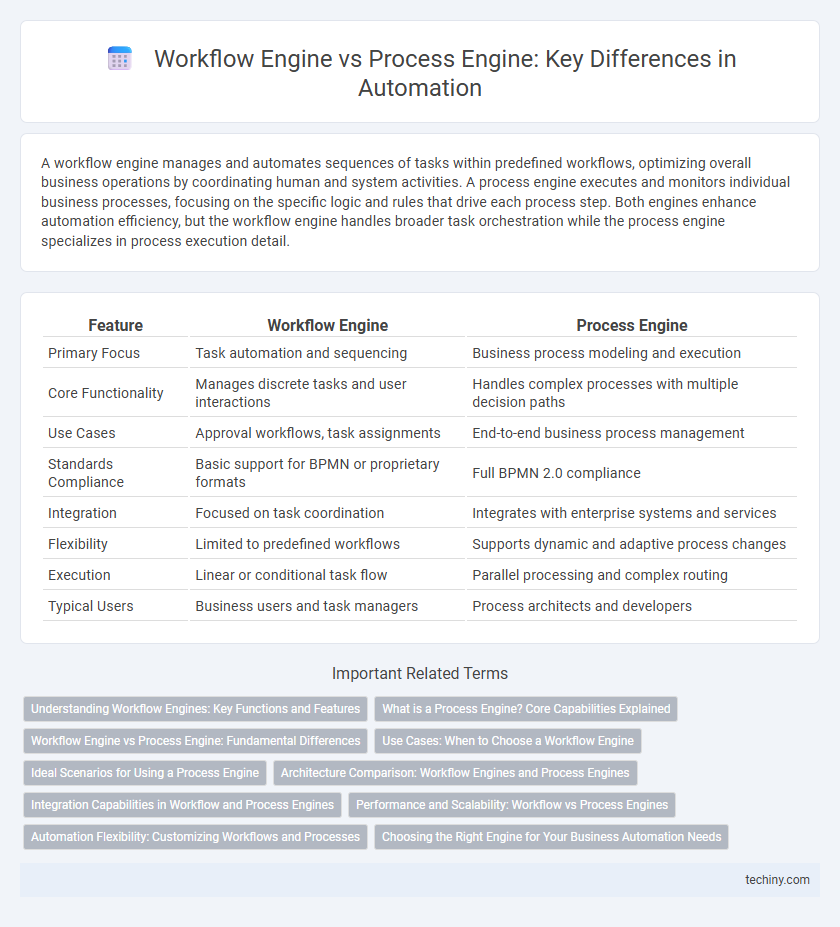A workflow engine manages and automates sequences of tasks within predefined workflows, optimizing overall business operations by coordinating human and system activities. A process engine executes and monitors individual business processes, focusing on the specific logic and rules that drive each process step. Both engines enhance automation efficiency, but the workflow engine handles broader task orchestration while the process engine specializes in process execution detail.
Table of Comparison
| Feature | Workflow Engine | Process Engine |
|---|---|---|
| Primary Focus | Task automation and sequencing | Business process modeling and execution |
| Core Functionality | Manages discrete tasks and user interactions | Handles complex processes with multiple decision paths |
| Use Cases | Approval workflows, task assignments | End-to-end business process management |
| Standards Compliance | Basic support for BPMN or proprietary formats | Full BPMN 2.0 compliance |
| Integration | Focused on task coordination | Integrates with enterprise systems and services |
| Flexibility | Limited to predefined workflows | Supports dynamic and adaptive process changes |
| Execution | Linear or conditional task flow | Parallel processing and complex routing |
| Typical Users | Business users and task managers | Process architects and developers |
Understanding Workflow Engines: Key Functions and Features
Workflow engines automate the orchestration of tasks by managing the sequence, conditions, and rules that define a business process, enabling seamless task execution and monitoring. Key features include task scheduling, event handling, human task integration, and real-time tracking to ensure optimized process flow. Unlike process engines that focus on executing business rules and logic, workflow engines emphasize coordination between multiple activities and resources across complex workflows.
What is a Process Engine? Core Capabilities Explained
A Process Engine is a software tool designed to model, execute, and monitor complex business processes by automating workflow tasks and ensuring seamless coordination between different systems and users. Core capabilities include process orchestration, rule execution, state management, and real-time process analytics, enabling organizations to optimize operational efficiency and reduce manual intervention. Unlike a workflow engine that primarily handles task sequencing, a process engine supports end-to-end process lifecycle management with advanced integration and decision-making features.
Workflow Engine vs Process Engine: Fundamental Differences
A Workflow Engine focuses on managing task sequences and human interactions within predefined workflows, emphasizing user activity and task assignments. In contrast, a Process Engine executes complex business processes automatically by interpreting process models, often integrating with various systems and handling rule-based logic. The fundamental difference lies in Workflow Engines orchestrating user-driven tasks, while Process Engines automate end-to-end process execution based on dynamic business rules.
Use Cases: When to Choose a Workflow Engine
A workflow engine is ideal for automating predefined, repeatable sequences of tasks requiring human interaction or decision points, such as approval processes and document routing. It excels in managing tasks with complex dependencies or escalations while providing real-time monitoring and user task management. Enterprises should choose a workflow engine when they need to model dynamic business workflows involving multiple participants and conditional logic.
Ideal Scenarios for Using a Process Engine
A process engine excels in managing complex, multi-step business processes that require strict adherence to defined workflows and detailed monitoring of state transitions. Ideal scenarios include large-scale enterprise resource planning, regulatory compliance tasks, and case management systems where process consistency and auditability are critical. Process engines support dynamic process changes in real-time, making them suitable for environments demanding high flexibility and robust exception handling.
Architecture Comparison: Workflow Engines and Process Engines
Workflow engines and process engines differ fundamentally in architecture, where workflow engines prioritize task automation and routing within defined sequences, often supporting human interaction and simple workflows. Process engines emphasize complex process orchestration with state management, event handling, and rule execution, aligned to standards like BPMN for scalable, end-to-end business process management. Workflow engines typically feature lightweight, modular designs for rapid task transitions, while process engines support comprehensive data modeling and integration capabilities essential for enterprise-grade automation.
Integration Capabilities in Workflow and Process Engines
Workflow engines excel in integrating with diverse applications and services through APIs, enabling seamless task automation across multiple platforms. Process engines feature robust BPMN support that facilitates deep integration with enterprise systems for complex business process orchestration. Both engines leverage connectors and middleware to optimize data exchange and enhance automation efficiency within organizational environments.
Performance and Scalability: Workflow vs Process Engines
Workflow engines excel in managing complex sequences of tasks with high performance, leveraging optimized state management to ensure rapid execution and easy scaling across distributed systems. Process engines prioritize business logic execution with robust transaction handling, often incurring higher overhead that can impact scalability under heavy loads. Choosing between workflow and process engines depends on specific performance requirements and scalability needs, where workflow engines typically deliver faster throughput and more efficient resource utilization in large-scale automation environments.
Automation Flexibility: Customizing Workflows and Processes
Workflow engines excel in automation flexibility by enabling users to customize task sequences and user interactions with drag-and-drop interfaces, making them ideal for dynamic, human-centric workflows. Process engines focus on automating backend processes with rigid, rule-based executions suited for system integration and transaction management. Combining both engines enhances automation flexibility by supporting customizable workflows alongside scalable process automation.
Choosing the Right Engine for Your Business Automation Needs
A workflow engine focuses on managing and automating predefined sequences of tasks, ideal for simpler, rule-based processes requiring clear task delegation. A process engine handles complex, dynamic business processes with conditional logic, enabling real-time decision-making and integration across multiple systems. Selecting the right engine depends on your business complexity, scalability requirements, and the need for flexibility in process automation.
Workflow Engine vs Process Engine Infographic

 techiny.com
techiny.com